Landscaping in Garden Maintenance: Enhancing Your Outdoor Space
Introduction to Landscaping in Garden Maintenance
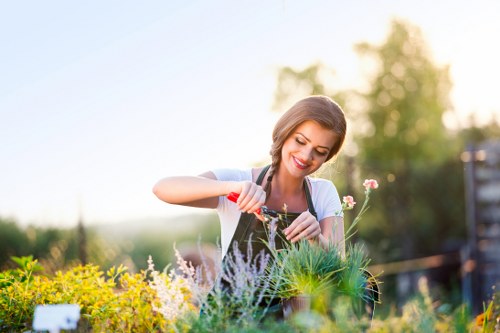
Landscaping plays a pivotal role in garden maintenance, transforming ordinary outdoor spaces into stunning, functional areas. By incorporating various plants, structures, and design elements, homeowners can create a harmonious environment that not only looks beautiful but also adds value to their property.
Effective garden maintenance through landscaping involves regular care, strategic planning, and a keen eye for detail. Whether you’re a seasoned gardener or a beginner, understanding the fundamentals of landscaping can significantly improve the health and aesthetics of your garden.
In this article, we will explore the key aspects of landscaping in garden maintenance, providing you with valuable insights and practical tips to maintain a vibrant and inviting garden all year round.
Planning Your Garden Landscape
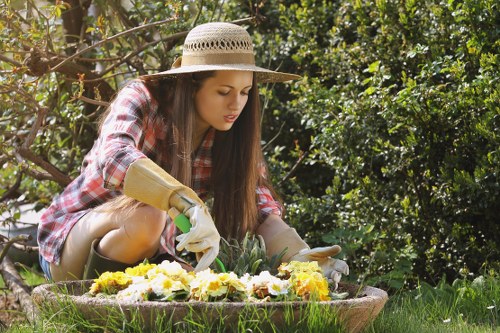
Assessing Your Space
Before diving into landscaping, it’s essential to assess your garden space. Consider factors such as size, sunlight exposure, soil quality, and existing vegetation. Understanding these elements will help you make informed decisions about plant selection and garden layout.
Setting Goals and Objectives
Define what you want to achieve with your garden landscaping. Whether it’s creating a peaceful retreat, growing your own vegetables, or designing a space for entertaining, setting clear goals will guide your landscaping efforts and ensure your garden meets your needs.
Designing the Layout
Once you’ve assessed your space and set your goals, the next step is designing the layout. Consider the flow of the garden, the placement of plants, pathways, and any structures like pergolas or water features. A well-thought-out design will enhance the functionality and beauty of your garden.
Choosing the Right Plants
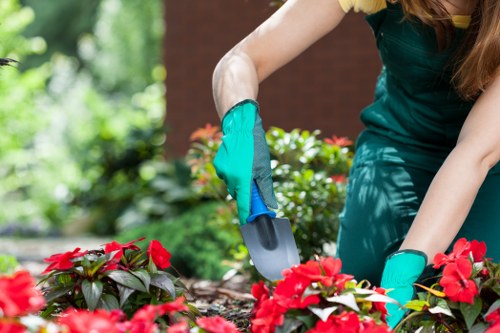
Selecting Based on Climate
Choosing plants that thrive in your local climate is crucial for successful garden maintenance. Research native plants that are well-suited to your area’s temperature, rainfall, and soil conditions. Native plants often require less maintenance and are more resistant to pests and diseases.
Diversity and Sustainability
A diverse range of plants can create a resilient garden ecosystem. Incorporate a variety of perennials, annuals, shrubs, and trees to ensure year-round interest and to support local wildlife. Sustainable gardening practices, such as using organic fertilizers and compost, can further enhance the health of your garden.
Color and Texture Coordination
Consider the colors and textures of the plants you choose to create visual interest and harmony. Complementary colors can make your garden more vibrant, while varying textures add depth and dimension. Mixing different plant types can prevent monotony and attract a variety of pollinators.
Soil Preparation and Maintenance
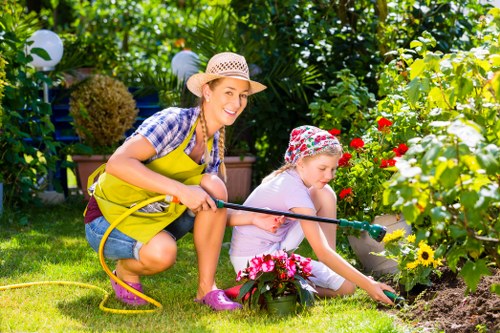
Testing and Improving Soil Quality
Healthy soil is the foundation of a thriving garden. Conduct soil tests to determine pH levels and nutrient content. Based on the results, amend the soil with appropriate materials such as compost, peat moss, or lime to create an optimal environment for plant growth.
Mulching Techniques
Mulching is an effective way to retain moisture, suppress weeds, and regulate soil temperature. Organic mulches like bark, straw, or leaf litter also add nutrients to the soil as they decompose. Apply mulch around your plants to maintain a consistent moisture level and reduce maintenance efforts.
Regular Maintenance Practices
Consistent maintenance is key to a healthy garden. This includes watering, weeding, pruning, and fertilizing. Establish a regular schedule to address these tasks, ensuring your plants receive the care they need to flourish throughout the seasons.
Irrigation Systems in Landscaping
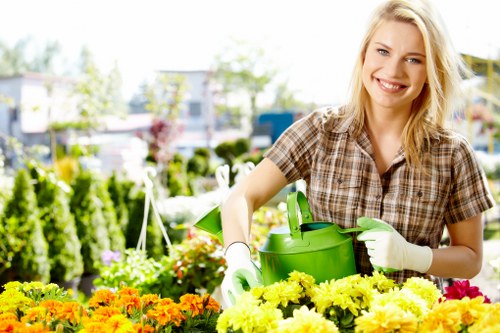
Types of Irrigation Systems
Choosing the right irrigation system can significantly impact the efficiency of your garden maintenance. Common types include drip irrigation, which delivers water directly to the roots, and sprinkler systems, which provide broader coverage. Consider the specific needs of your plants and the layout of your garden when selecting an irrigation method.
Water Conservation Strategies
Implementing water conservation strategies not only benefits the environment but also reduces your water bills. Techniques such as rainwater harvesting, using drought-resistant plants, and optimizing irrigation schedules can help conserve water while keeping your garden healthy.
Automation and Smart Technologies
Modern technologies offer automated irrigation systems that can be controlled remotely. Smart controllers adjust watering schedules based on weather conditions, ensuring your garden receives the right amount of water without unnecessary waste. Investing in automation can save time and enhance the efficiency of your garden maintenance.
Pest and Disease Management
Identifying Common Pests
Monitoring your garden for pests is essential for maintaining plant health. Common garden pests include aphids, slugs, and caterpillars. Early identification allows for prompt intervention, preventing significant damage to your plants.
Natural and Chemical Control Methods
When dealing with pests and diseases, it’s important to choose appropriate control methods. Natural options like introducing beneficial insects or using organic pesticides can effectively manage pests without harming the environment. In cases of severe infestations, chemical treatments may be necessary, but should be used judiciously to avoid negative impacts.
Preventative Measures
Preventing pest and disease issues is often easier than treating them. Practices such as crop rotation, maintaining plant diversity, and ensuring good air circulation can reduce the likelihood of infestations. Regularly inspecting your garden and removing diseased plants can also help maintain a healthy environment.
Seasonal Landscaping Tips
Spring Maintenance
Spring is a critical time for garden maintenance. Begin by clearing any debris that accumulated over the winter. Plant new flowers and vegetables, and perform a thorough pruning of shrubs and trees. Applying a fresh layer of mulch can also help prepare your garden for the growing season.
Summer Care
During the summer months, focus on watering and protecting your plants from heat stress. Implementing shade structures or using shade cloths can help prevent sunburn on sensitive plants. Regularly check for pests and diseases, and adjust your irrigation practices to accommodate the hotter weather.
Autumn Preparations
As temperatures begin to drop, start preparing your garden for winter. Remove any dead or diseased plants, and plant bulbs for spring blooms. Raking fallen leaves and adding compost to your soil can improve soil fertility and structure, setting the stage for a healthy garden next year.
Winter Protection
Protecting your garden during the winter is essential to ensure plants survive the colder months. Use frost covers or burlap to shield delicate plants from freezing temperatures. Mulching around the base of plants can help insulate roots, and ensure any perennial plants are properly mulched to prevent frost damage.
Hardscaping Elements in Garden Maintenance
Pathways and Walkways
Incorporating pathways and walkways into your garden design not only adds structure but also enhances accessibility. Materials such as gravel, stone, or wood can be used to create aesthetically pleasing paths that guide visitors through your garden seamlessly.
Outdoor Structures
Adding structures like pergolas, gazebos, or garden arches can create focal points and provide functional spaces for relaxation or entertainment. These elements can also support climbing plants, adding vertical interest to your garden.
Water Features
Water features such as fountains, ponds, or waterfalls bring tranquility and a sense of movement to your garden. They can attract wildlife, provide a cooling effect, and serve as a centerpiece that enhances the overall ambiance of your outdoor space.
Lighting and Garden Aesthetics
Types of Garden Lighting
Proper lighting can transform your garden by highlighting key features and creating a magical atmosphere during the evening hours. Options include ambient lighting, such as string lights, task lighting for pathways, and accent lighting to showcase plants and architectural elements.
Energy-Efficient Solutions
Opting for energy-efficient lighting solutions, such as LED fixtures or solar-powered lights, can reduce your energy consumption and lower maintenance costs. These options provide ample illumination while being environmentally friendly.
Designing with Light and Shadow
Strategically placing lights can create captivating patterns of light and shadow, adding depth and dimension to your garden. Experiment with different angles and intensities to achieve the desired effect, enhancing the visual appeal of your outdoor space.
Maintaining Garden Structures
Upkeep of Pergolas and Gazebos
Garden structures like pergolas and gazebos require regular maintenance to preserve their appearance and functionality. Inspect for any signs of wear or damage, and perform necessary repairs promptly. Applying protective coatings or stains can extend the lifespan of wooden structures.
Fence and Gate Maintenance
Fences and gates define the boundaries of your garden and provide security. Regularly clean and treat them to prevent rust, rot, or deterioration. Ensure that gates function smoothly and make any adjustments or replacements as needed.
Decorative Elements
Incorporating decorative elements such as statues, birdbaths, or garden art can personalize your garden space. These features should be maintained to keep them looking their best, enhancing the overall aesthetic appeal of your garden.
Tools and Equipment for Garden Maintenance
Essential Gardening Tools
Having the right tools is essential for efficient garden maintenance. Basic tools include a sturdy shovel, pruning shears, a garden hose, and a wheelbarrow. Investing in high-quality tools can make maintenance tasks easier and more enjoyable.
Maintenance of Tools
Proper maintenance of your gardening tools extends their lifespan and ensures they perform effectively. Clean tools after each use, sharpen blades as needed, and store them in a dry, protected area to prevent rust and damage.
Utilizing Technology
Modern technology offers a range of tools to simplify garden maintenance. Robotic lawn mowers, smart irrigation controllers, and garden management apps can help automate tasks, monitor plant health, and optimize maintenance routines.
Sustainable Landscaping Practices
Organic Gardening
Organic gardening focuses on using natural methods and materials to cultivate plants. Avoiding synthetic fertilizers and pesticides reduces environmental impact and promotes a healthier garden ecosystem. Incorporate composting, natural pest control, and organic fertilizers to maintain soil fertility and plant health.
Water Efficiency
Implementing water-efficient practices ensures your garden remains sustainable. Techniques such as drip irrigation, rainwater harvesting, and selecting drought-tolerant plants can significantly reduce water usage while maintaining garden vitality.
Recycling and Upcycling
Recycling materials used in your garden contributes to sustainability. Use recycled containers for plants, repurpose old furniture as garden decor, and utilize natural waste as compost. Upcycling not only minimizes waste but also adds unique character to your garden space.
Final Thoughts on Landscaping in Garden Maintenance
Continuous Learning and Adaptation
Garden maintenance is an ongoing process that requires continuous learning and adaptation. Stay informed about new gardening techniques, plant varieties, and sustainable practices to keep your garden thriving and up-to-date with current trends.
Personalizing Your Garden
Your garden is an extension of your personality and lifestyle. Don’t be afraid to experiment with different styles, plants, and structures to create a space that truly reflects your tastes and meets your needs. Personal touches make your garden uniquely yours.
Enjoying the Fruits of Your Labor
Ultimately, the goal of landscaping in garden maintenance is to create a space that brings joy and relaxation. Take the time to appreciate your garden’s beauty, spend time outdoors, and enjoy the peaceful environment you’ve cultivated through diligent maintenance and thoughtful landscaping.
Contact us today to transform your garden into a stunning outdoor oasis!